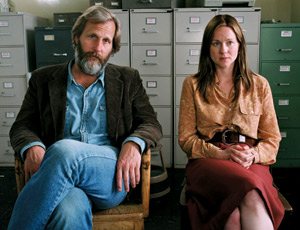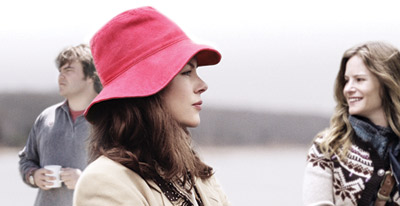BY ROB FELD
From the time he was 25 and directed his first film, Kicking and Screaming, Noah Baumbach has made cerebral movies about cerebral people. His characters are self-conscious to the point of paralysis, frequently boxed in and rendered dysfunctional by their own sense of privilege and expectation.
But for all their headiness, Baumbach's films are nothing if not compelling, using his cinematic savvy to thrust the audience into the story. Kicking and Screaming, released in 1995, overflows with sharp wit, Gen-X anxiety, pop culture references and a Jean Renoir-influenced, fluid camera that keeps the scenes moving.
Still, Baumbach hadn't found his voice as a director. "I left college with this idea that I wanted to make films. Then, suddenly, I was making films, but then had to acknowledge that I wasn't exactly sure what kind of films I wanted to make—which was a strange position to be in."
A few years later, he was playing around with a script about brothers close to his own age who were thinking about their parents' divorce when they were children, and he went to see a screening of Louis Malle's Murmur of the Heart. "Then I thought, 'Why not come at this from the time it happened? Write about the kids going through it.' And probably six months later I had a rough draft that was pretty connected in spirit to what I ended up shooting four years later as The Squid and the Whale.
"It was exciting because I felt I'd had a breakthrough. It was the subject matter, the people, the setting and all that stuff, but also just the way I wrote it. I felt like I was more connected to all the characters and in their heads in a way I hadn't felt on previous scripts. I was more open. My feeling about Squid and Whale is that it's the movie I always wanted to make that I didn't know I was going to make."
 BAD VIBES: Jeff Daniels and Laura Linney play a couple whose marriage
BAD VIBES: Jeff Daniels and Laura Linney play a couple whose marriage
is coming apart in The Squid and the Whale. (© Samuel Goldwyn Films)The Squid and the Whale marked a major development in Baumbach's style. He had also been watching documentaries by the Maysles Brothers, Frederick Wiseman and D.A. Pennebaker and his film had the look of cinema verité. It was grainy, shot on Super 16 mm with a handheld camera and minimal use of establishing shots, not allowing the audience a chance to step back and leave the moment.
Now, with Margot at the Wedding, Baumbach continues his cinematic exploration with an even rougher hewn feel to an even darker story that revels in ambiguity and boasts all the twisted family ties and psychosexual angst of the Ingmar Bergman films he was watching as he prepared to make it. Margot (Nicole Kidman), in the midst of leaving her husband (John Turturro), brings her adolescent son to her childhood home on an island, now inhabited by her sister Pauline (Jennifer Jason Leigh) and her fiancé (Jack Black).
Mental stability does not run in the family but, aided by Baumbach's nervous camera and editing, it remains unclear exactly who is being abusive to whom. "With Margot, after making Squid, I was more confident and aware of the way I wanted the film to feel and how to provide entrée into a movie," Baumbach explains. "I think there's a feeling of discovery throughout, which mirrors my discovery of the script, because I didn't know what I was writing. I liked the idea of opening with a kid on the cusp of puberty on a moving train, seeing the world differently, feeling differently, his body changing, everything moving."
The director wanted it to be near impossible to watch Margot and not be involved in what's happening. "I'm increasingly interested in making movies that are experiences for the audience, without a lot of reaction shots, that don't have markers to tell you how to feel about a scene or person," he says. So he cuts out of scenes in the middle of lines or during an unresolved moment, or his camera comes upon an event too late to discern the reality of what it sees. The tangled psychology of Baumbach's characters and the ambiguity of their perceptions, presented so subjectively, leave questions of truth dangling before his audience in ways that feel very real. The ambiguous image of the squid grappling with the whale in The Squid and the Whale seems an apt metaphor for Baumbach's work, where it can be impossible to tell who's getting the upper hand.
Baumbach achieves this uncertainty through style a method of working more than than a deliberate attempt at style. "I don't think consciously about the rough edges," he says. "I just allow them to happen. The camera is handheld but held steadily, so it can pick up things in a scene if a character moves. You sense a human presence. It feels captured in a way I don't think calls attention to itself and offers the freedom to shoot without lighting all day for the one long dolly shot, which I don't think these stories call for."
Baumbach and his cinematographer, Harris Savides, chose to shoot in 35 mm to avoid complicated lighting setups as much as possible and used old 35 mm and 50 mm lenses to get the feel they wanted. On top of which, they flashed the film.
"It caused funny difficulties," Baumbach recalls. "These old lenses were really imperfect so that there would be soft parts, even though it would be in focus. There would be a softness that would really throw you off in dailies. But I felt it was worth it because it evoked this unusual, almost indescribable feeling, and emphasized the film aspect of it in a way I really liked. It was the closest I'd come to actually achieving the look I had fantasized."
 THE DARK SIDE: Noah Baumbach wanted to thrust his audience into the drama of Margot at the
THE DARK SIDE: Noah Baumbach wanted to thrust his audience into the drama of Margot at the
Wedding starring Jack Black, Nicole Kidman and Jennifer Jason Leigh. (© Paramount Vantage)
In Margot, the viewer can find oneself in the next scene before fully comprehending what just happened in the last one. "I like this idea of scenes crashing into each other," Baumbach explains. "It feels like an experience, or our perception of experience. I don't often know, in my regular life, how I feel in the middle of a conversation with someone, for example. Often that comes later. I think the movie is structured that way."
Baumbach has increasingly tried to script these lifelike moments—such as one in Margot where her sister drops plates in the kitchen in the middle of her line, followed by a cut and an instant of confusion—but many of them are discovered in editing as well.
"There are times where I would feel like, 'Wouldn't it be great if we were just into the next scene?' I think part of it is not thinking of them as scenes, but as a whole. If you think about it in that way then it's okay for the scene to bleed over. I do it with sound, too."
For example, Baumbach mentions a scene when John Turturro stops the car to pick up an injured dog. "The scene ends with Nicole Kidman saying, 'Take me home and go away.' It wasn't scripted but she gave an exhale, which I found very moving. When [editor] Carol Littleton and I were cutting the movie, we brought the exhale over onto Jennifer's face in the next scene, as she's eating Chinese food. I like that. When you're cutting and bringing in sounds and music, and people are bringing in their interpretations of lines, you can find great things."
At some point Baumbach says he might direct something that feels less rough and will be shot in a more conventional way. But for now, this is how he is seeing the world. "Our everyday experiences don't have establishing shots," he says. "They don't announce themselves, they're frequently obtuse and hard to decipher. Sometimes, in a movie, you need those things to convey information, and there are scenes in Margot that end more comfortably than others, but in general I want the audience to participate. I think this can be very pleasurable."